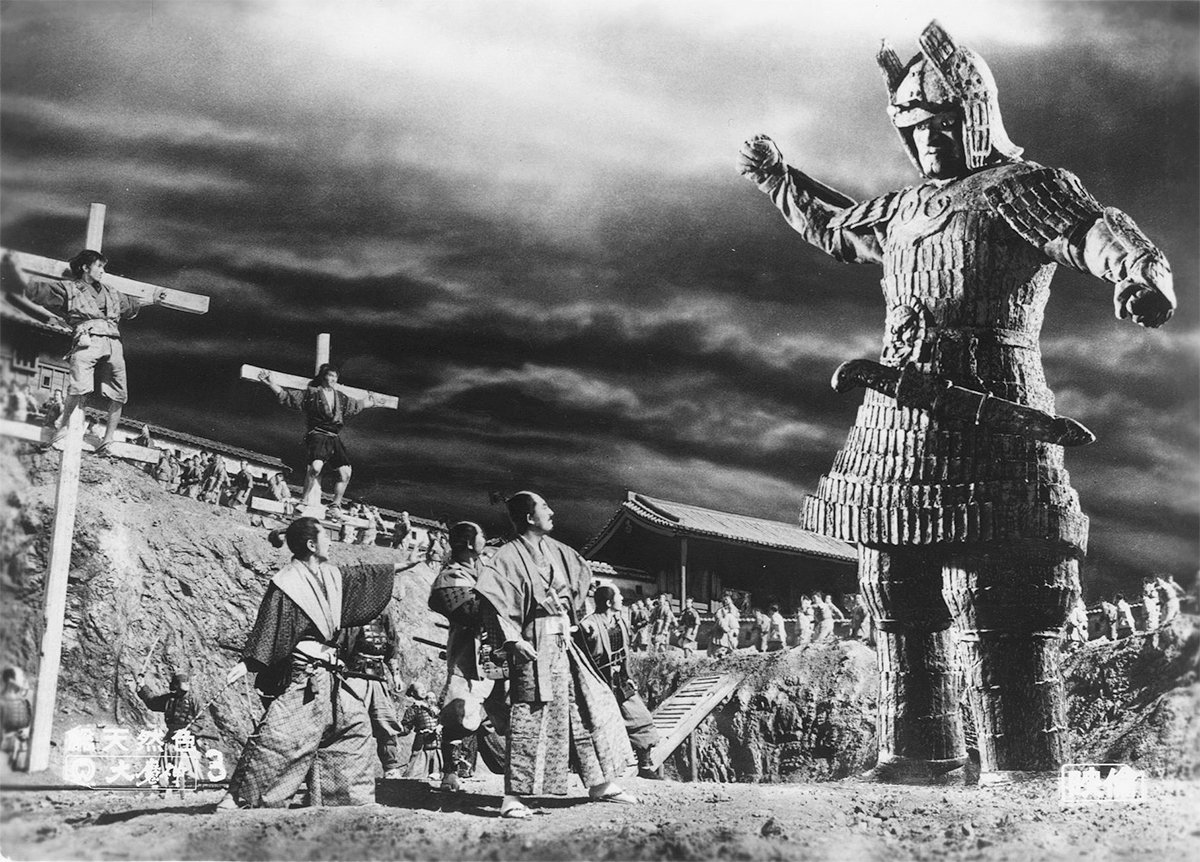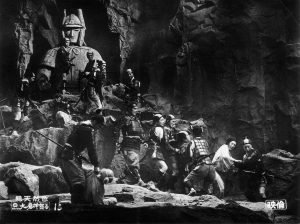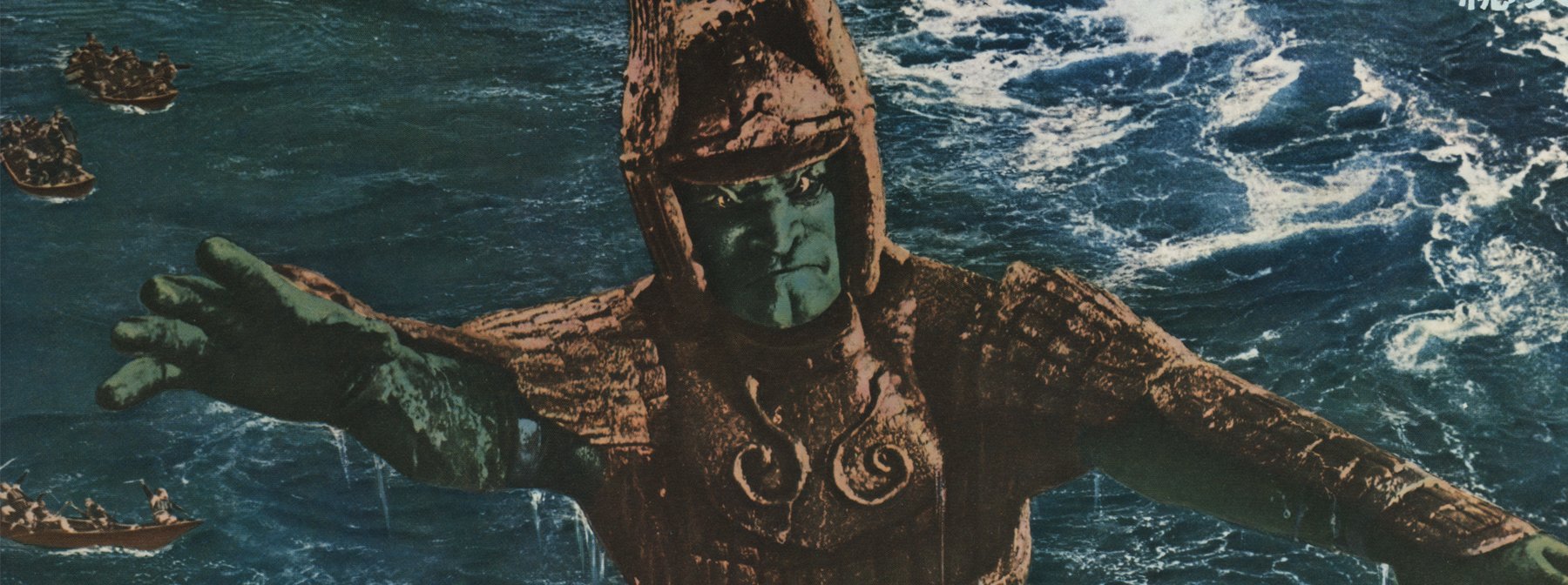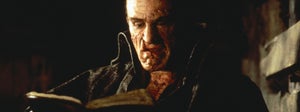
1966 was the year to be a monster kid in Japan. Throughout those 365 kaiju-crammed days, you’d have been spoiled for choice before a veritable all-you-can-eat buffet of giant monster mayhem: you could be whisked away by the South Seas adventures of Ebirah, Horror of the Deep, thrill to the spectacular brutality of The War of the Gargantuas, cheer on the titanic terrapin against his frosty nemesis in Gamera vs. Barugon, and be enchanted by the whimsical wonders of The Magic Serpent. Destruction reigned on the small screen too, with both Ultra Q and Ultraman debuting at separate points in the year and leaving an unstoppable pop-culture behemoth in their wake. Across three exceptional films, 1966 also saw the debut of a very different kind of kaiju – a towering idol of living stone forged in man’s image, benign in ambivalence until provoked into violent retribution. A vengeful devil and a terrible protector, a literal giant demon god summoned by the tears of the innocent to punish the sins of the wicked. It’s too late to repent, evildoers – Daimajin has awakened.
Daimajin’s debut trilogy represent an outlier in terms of kaiju film production. The three features were conceived and produced concurrently by Daiei Kyoto studios – the fabled home of Shintaro Katsu’s blind swordsman Zatoichi, and countless other chambara pictures which comprised the studio’s bread and butter – and all released in the same year mere months apart. Daimajin was directed by Kimiyoshi Yasuda (various Zatoichi and Sleepy Eyes of Death pictures), Return of Daimajin by venerated chambara director Kenji Misumi (of Lone Wolf and Cub and – by proxy – Shogun Assassin fame), and Wrath of Daimajin by Kazuo Mori (Zatoichi At Large).
In contrast to Ishiro Honda, Jun Fukuda, or Daiei’s own Noriaki Yuasa’s shepherding of the Gamera series, Yasuda, Misumi, and Mori were not experienced kaiju directors but were exactly what the Daimajin films required: seasoned chambara veterans who could bring a greater sense of dramatic realism and human weight to their spectacular scenes of deity-wrought destruction. Astonishingly, all three films were written by Tetsuro Yoshida, edited by Hiroshi Yamada, photographed by Fujio Morita, produced by the legendary Masaichi Nagata, and scored by celebrated Godzilla veteran Akira Ifukube all within the same year. The colossal idol Majin himself was portrayed in all three films by professional baseball player and actor Chikara Hashimoto, who famously portrayed villainous Hongkou dojo master Hiroshi Suzuki opposite Bruce Lee in Fist of Fury (1972).

The Daimajin trilogy’s title character and themes of retribution have their basis in Jewish folklore narratives surrounding the Golem of Prague: an allegorically-versatile anthropomorphic being created from inanimate matter, typically mud or clay, who – like Majin – can play the role of both protector and destructor depending on circumstance. The Golem also provided cinematic influence: producer Nagata allegedly drew inspiration from the 1936 Czechoslovakian-French monster picture Le Golem, rather than the more famous and influential silent picture The Golem: How He Came into the World (1920). The trilogy’s cinematic forebears from Daiei’s own stable include Misumi’s 70mm Technirama epic Buddha (1961, also scored by Ifukube and starring Return of Daimajin lead Kojiro Hongo in the title role) and The Tale of Zatoichi (1962, also directed by Misumi), the first entry of the prolific saga and a prime example of the chambara fare Daiei Kyoto so excelled at.
Like any deity worth the worship, Majin himself has left significant influence and inspiration in his wake. While the stone demon did not reach the English-speaking world until 1968, the immediately prior year’s It! – a Seven Arts British horror deliberately emulative of Hammer’s lavish productions – does beg mentioning. The film depicts the Golem of Prague rampaging into the Atomic Age, arriving in a London museum in the 1960s and brought to life by meek but sinister curator Arthur Pimm (Roddy McDowall). An eventual effort to dispatch the Golem via nuclear warhead proves fruitless and – much like Majin – represents a victory of the fantastic and spiritual over the meagre might of man’s weaponry. Back in Japan, Daiei’s immediate successor to Daimajin was the original Yokai Monsters trilogy (1968 and ’69), three exceptional films that also genre-mash chambara and the fantastic through their depiction of strange encounters with supernatural beings of Japanese folklore throughout feudal Japan. Daimajin director Yasuda directed and co-directed, respectively, the first and third entries (100 Monsters and Along With Ghosts), while Majin suit performer Hashimoto portrayed the vampiric Babylonian demon Daimon in the standout middle entry, Spook Warfare.
Go Nagai’s anime, manga, and novel series God Mazinger (1984) – part of the long-running Mazinger giant robot saga – tells the story of teenager Yamato Hino, who is transported to the ancient Kingdom of Mu in order to awaken the great god Mazinger – a giant stone statue and defender of the realm – to defend against the tyrannical threat of the evil Dorado of the Empire of Dinosaurs. While Majin only fought against human antagonists in his initial appearances, the mountain god’s influence is clear in Nagai’s saga. Earlier in the ’80s, Toho veteran Ishiro Honda was allegedly approached regarding helming a new Majin feature; however, the seasoned director was already hard at assisting in the resurrection of another Japanese film giant – his lifelong friend Akira Kurosawa, with their epic collaboration Kagemusha (1980) reviving and revitalising the careers of both men.

Majin did eventually revive in the ‘80s – just not in an official capacity. Masahiko Katto’s 1988 feature-length independent spectacle The Resurrection of Daimajin depicts the sleeping giant awakening in contemporary Japan, rampaging through modern cityscapes and dispensing with trains and artillery with true kaiju flair. The film has never been commercially released on home video in any format but did receive limited theatrical screenings in Japan upon completion. Elsewhere, North Korea’s infamous solo giant monster feature Pulgasari (1985) – the production of which is too complicated to begin to touch upon here – features a giant creature birthed from a rice doll, who (in some mixed messaging) proceeds to defend its oppressed creators from tyrannical warlords. Rumours even persist that Kevin Costner was circling a Majin film with Hong Kong’s Golden Harvest in the early 1990s. Perhaps Robin Hood: Prince of Thieves (1991) – another tale of a mythical figure rising up to defend the meek against the corrupt, violent, and greedy – could grant us a look at what spectacle and adventure Costner’s Daimajin may have offered.
Majin finally, unambiguously returned to screens in the 21st Century in the form of a serialised TV drama. Daimajin Kanon (2010) saw a group of Kamen Rider-esque yokai attempting to revive the legendary idol in contemporary Japan in order to thwart the machinations of a spiritual evil. Over a decade later, Majin returned to the big screen at last in The Great Yokai War: Guardians (2021), Takashi Miike’s tardy sequel to his own The Great Yokai War (2005). As a testament to his enduring star power, two life-size Majin statues even adorn the entrance to the historic site of Daiei’s Tokyo studios. While Majin’s appearances remain few and far between, the Earth-trembling impact of his imposing figure and outstanding films is still felt today. Like any worthy deity, he continues to inspire reverence, worship, and loyalty among devotees, proving once and for all that Daimajin is no idol threat.
https://www.youtube.com/watch?v=HII2E4F3axw&pp=ygUWZGFpbWFqaW4gdHJpbG9neSBhcnJvdw%3D%3D









